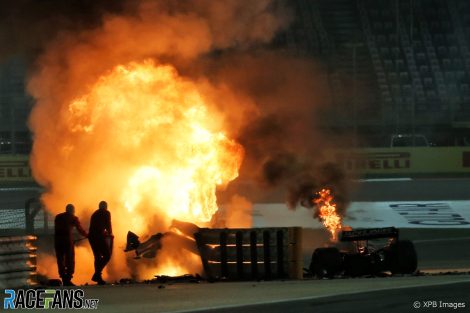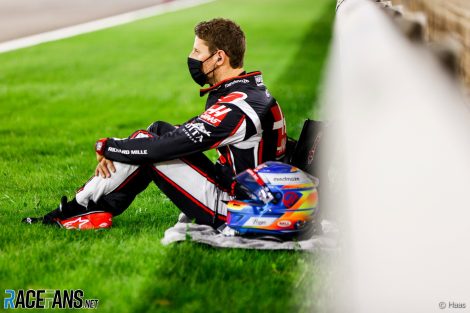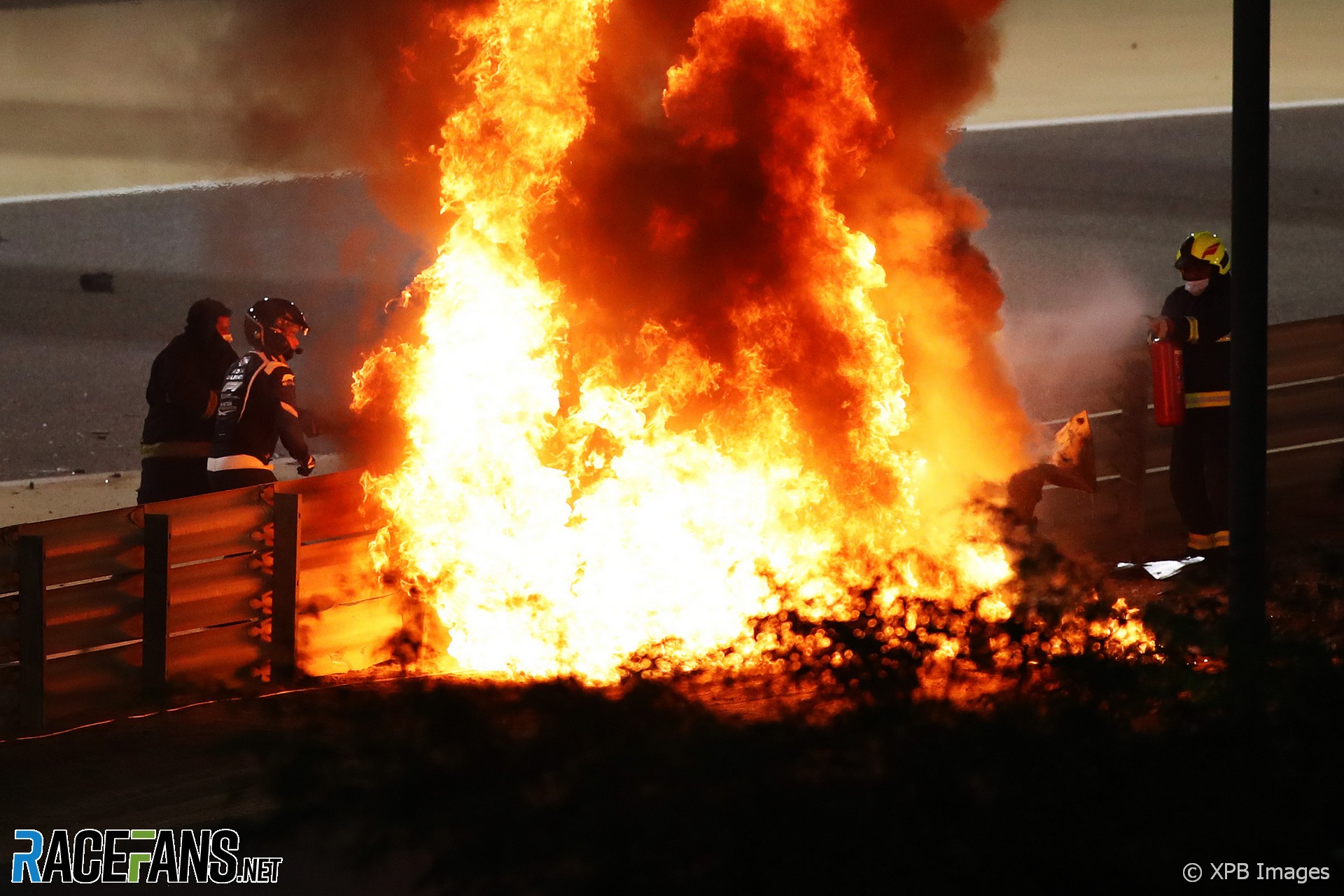The FIA has announced the findings from its investigation into Romain Grosjean’s fireball crash during last year’s Bahrain Grand Prix, and identified over 20 areas where driver safety can be improved.
The Serious Accident Study Group, which is chaired by FIA president Jean Todt, examined an investigation which drew on physical evidence from the crash, data captured by the car and Grosjean’s in-ear accelerometer, and video footage.The report confirmed details of the severity of the impact Grosjean suffered. His peak impact force with the barrier was determined as being 67G at a speed of 192kph. The impact caused the middle rail of the barrier to fail, and his survival cell became trapped within it.
“The driver safety equipment including helmet, HANS and safety harness as well as the survival cell, seat, headrest and Halo frontal cockpit protection performed according to their specifications in protecting the driver’s survival space and managing the forces applied to the driver during the impact,” noted the report.

The FIA has made 22 safety recommendations based on its analysis of the Grosjean incident and the safety team’s response to it, and 18 other serious accidents which occurred in circuit racing during 2020.
Among the recommendations specified by the report, as previously revealed by RaceFans, are improvements to the fuel hatch, footwell and headrest on F1 cars.
Grosjean’s foot was trapped beneath his pedals following the crash, forcing him to pull his foot from his racing boot in order to free himself. His headrest was damaged in the impact which “significantly restricted the path for driver egress”, stated the FIA.
Advert | Become a RaceFans supporter and
He suffered burns to his hands due to the fire, caused by fuel which leaked from two locations. These were the fuel tank inspection hatch on the left-hand side of the car, which was dislodged in the impact, and the engine fuel supply connection which was torn from the safety bladder on the fuel tank.

Circuit safety measures will also be addressed, including a review of the position of circuit barrier opening installations. Grosjean struck a section of barrier where such an opening was situated. The barrier was revised for Formula 1’s second race at the venue on the weekend after Grosjean’s crash.
Improvements to driver safety equipment and the equipment and training for medical and rescue teams are also planned.
The full list of areas the FIA intends to address following its analysis of the 19 incidents including Grosjean’s crash are as follows:
Advert | Become a RaceFans supporter and
Vehicle
- Regulation of survival cell front geometry, plus additional load tests in that area
- Review of existing regulations regarding rear view mirrors
- Review of steering column mounting requirements
- Review of regulation and homologation requirements for headrest assembly
- Analysis of power unit mounting and mount failure modes
- Ongoing research project: wheel restraint cables (tethers)
- Design review of safety fuel bladder installations in all FIA single seater categories
- Recommendations for safety fuel bladder installation best practice
- Update of the FIA Standard for safety fuel bladders
- Review of regulations for design of safety fuel bladder connections and inspection hatches
- Fuel homologation to include compatibility of bladder material and specific fuel
Circuit
- Increased functionality for Circuit Safety Analysis Software (CSAS) including quantitative impact probability classification
- Review of existing circuit barrier opening installations
- Review of guidelines/process for circuit homologation and licence renewal
Driver safety equipment
- Investigation into improvements to the gloves’ Heat Transfer Index (HTI)
- Ongoing research project: Visor opening/locking mechanisms; project scope extended to include requirements to ensure that visor opening systems are operational after being exposed to fire
- Ongoing research project: Extinguisher system for open cockpit cars; project scope extended to include investigation of improved activation mechanisms
Medical and Rescue
- Updates to Medical Intervention Vehicle equipment, including alternate extinguisher types
- Provide ASN [motorsport club] guidance on post-fire decontamination
- Ongoing development of FIA firefighting training module for ASNs
- Ongoing development of FIA high voltage safety training module for ASNs
- Ongoing development of FIA Incident Command/Co-ordination training module for ASNs
The FIA Safety Department also plans research projects on proximity warning systems for drivers, new and upgraded barrier systems, and firefighting equipment.
“Important learnings have been drawn from these investigations that will drive our continuous mission to improve safety in Formula 1 and global motor sport,” said Todt.
“The enduring commitment of the FIA, particularly the Safety Department, on reducing risks associated with motor sport enabled Romain Grosjean to maintain consciousness and survive an accident of this magnitude. Safety is and will remain the FIA’s top priority.”
2021 F1 season
- Verdict on error in GT race suggests Mercedes would have lost 2021 Abu Dhabi GP appeal
- Title ‘stolen’ from Mercedes made us ‘underdogs people cheer for’ – Wolff
- Red Bull Racing spent £230m during Verstappen’s title-winning 2021 campaign
- ‘I can’t box?’: Hamilton and Verstappen’s 2021 Abu Dhabi GP radio transcript
- Abu Dhabi’s legacy one year on: How the controversial 2021 finale changed F1





J_Olivier
5th March 2021, 19:04
I, like I suspect many fans, could point to those areas of improvement without the need of the crash, yet FIA keeps doing everything wrong. We still have the incoming Dutch GP in a circuit that clearly doesn’t meet the requirements that have been imposed to other tracks, just as an example.
someone or something
5th March 2021, 23:14
I’ll be honest, I’ve been trying to come up with a suitably snarky reply, but the level of armchairing is so absurd, I simply cannot even
MacLeod (@macleod)
6th March 2021, 0:28
why doesn’t meet Zandvoort the requirements? as the FIA approved? Did you visit yourself? Barriers have techno stuff added on the dangerous parts.
schooner (@schooner)
5th March 2021, 20:09
While the mandated safety equipment mostly did its job, particularly (and praise!) the halo, the fact remains that if Grosjean’s car (survival cell) had come to a rest in any number of different positions than it ultimately did, he might not have been able to extricate himself. I am so so glad that this shocking accident had a mostly happy ending, but I think that there will always be an element of “luck” involved in these sorts of things.
Delphi
6th March 2021, 2:28
I’ve thought about this a few times for a couple of hours in total and I imagine FIA have much smarter people, much better qualified looking at all factors and constraints (including some extremely limited circuit budgets) ie. they’ve probably been here.
But it occurred to me that being designed for public roads, Armco usually doesn’t face a challenge capable of separating/penetrating leading to Grosjean’s biggest problem (and very, very fortunate escape from) entanglement.
Stitch bolting longitudinal armco sections together in vulnerable track areas would be pretty cheap and make the fence work as a unit rather than spaghettifying into a hazard. Big box of little brackets and cup-head bolts – done.
Balue (@balue)
5th March 2021, 20:48
I’m surprised they are even going to consider this, and will be even more surprised if they actually do something about it even if walls are angled outward and IMO the root of the issue.
Also would like to see alternate extinguisher types for the trackside marshalls and not just the medical car.
Steve
5th March 2021, 21:57
SAFER
Ed
5th March 2021, 22:08
I think the key here is looking at this accident and seeing what can be learned from it. “Freak” accidents are just that a freak event that its statistical probably while not impossible are improbable. The CSAS sytem they are using measures the features of a circuit and applies a statistical model of trajectories and impacts into a barrier basd on its location. The barrier Grosjean hit probably had a low rating on the scale BUT now that they know what can happen they will look at other barriers, either with a similar physical property or probability and look to make changes. Yes it might not save the next person but a worthwhile cause to try.
JohnH (@johnrkh)
5th March 2021, 23:46
@Ed No such think as a “freak” accident or a “Black Swan Event”= something that is unforeseeable. What is difficult is to prepare for every possible type of incident under every set of circumstances.
Tommy C (@tommy-c)
6th March 2021, 6:31
Unforeseeable accidents happen all the time. That’s how we refine safety.
JohnH (@johnrkh)
6th March 2021, 8:54
@tommy-c If you’re having “unforeseeable” accidents all of the time you haven’t done a very good job of refining safety have you. I say that with my experience of 30+ years of being a Safety Advisor for government and authorities in construction-high rise and underground, road and rail as well as general construction.
F1JohnS (@)
7th March 2021, 14:56
@tommy-c Think you may mean unforseen rather than unforseeable, small change to wording but whiole different panorama.
anon
6th March 2021, 16:07
@tommy-c as @johnrkh notes, quite a lot of the time those “unforeseeable” accidents were in fact foreseeable, and indeed in quite a few cases there have been enough near misses that acted as a warning about the final accident occurring.
More usually, it’s factors such as being rushed due to concerns over cost or time, late changes in plans that haven’t been properly planned out or people not properly paying attention because they have forgotten about the last major accident. JohnH is right to point to the rail industry, which is getting quite heavily criticised in recent years for a worsening safety record because of concerns that getting things done quickly and cheaply is now more of a priority than getting it done safely – in part because too few people now remember how badly wrong things can go if safety is compromised, and too many now pay lip service to safety concerns.
It is the thing that concerns me most about the way that the FIA has been managing races in recent years, and the rather inconsistent approach that has been adopted with regards to marshalling and race direction. There have been more than a few incidents that smack of wanting to get things done fast, rather than wanting to get things done safely, and that a marshalling accident may only be a matter of time.
John H (@john-h)
5th March 2021, 22:56
Pleased to see they are looking into the mirrors. The 2021 cars don’t look much different however in this regard, something they could have changed a little earlier than 2022 one feels.
Tommy C (@tommy-c)
6th March 2021, 6:27
Proximity warning systems? Is that not the ultimate driver aid? I thought the proximity warning system was the drivers’ brains with their vast number of years of experience, but anyway…
S
6th March 2021, 10:42
It’s a good one, but the ultimate driver aid is having the fastest car.
RP (@slotopen)
6th March 2021, 13:20
@tommy-c
My experience with motorsport is the helmet makes seeing a major challenge. F1 cars take it to the extreme. The cockpit is at eye level. They can’t move their heads much. The turning and braking must make it challenging to hold the eyes steady enough to see.
Better mirrors and proximity systems would be a great use of F1s resources. It would make racing safer and could lead to the kind of road relevant improvements that keep the tech interesting for fans like me.
I’m not the least bit worried it would dull racing. Drivers will still have to struggle with the information and respond. They’ll still challenge and bluff each other.
Rhys Lloyd (@justrhysism)
8th March 2021, 9:13
@slotopen need to adopt the aeroscreen then project onto it arrows indicating where surrounding cars are like all the arcade racing games have.
I’m half joking. It sounds silly but all the tech for it exists already and it would vastly improve safety. Although it would make the sneak attacks much harder; unless your Danny Ric sending it from before the indicator even shows up.
Rhys Lloyd (@justrhysism)
8th March 2021, 9:13
**you’re
Edit button already FFS!!
whatevr
7th March 2021, 2:21
Blind spot monitoring – clearly a failure mode for that accident.
JacobC
11th May 2021, 7:29
As for you to say, but in an F1 car about 75% of the vehicle is a blind spot.
AJ
6th March 2021, 13:44
So the root of the problem was the failure of a barrier, but the recommendations do not list AT ALL stopping the use of split Armco barriers designed for road cars? Absolutely negligent and insane.
Steve Rogers (@beeflin)
6th March 2021, 15:42
I’m very glad gloves are being assessed, because despite every other factor involved in the accident, Romain’s gloves were the only factor that allowed him to be seriously injured. I hope they will be improved enough that an identical crash in the future would produce merely a wrenched foot.
JacobC
11th May 2021, 7:30
Gloves are really really hard because the material must be thin enough to allow the driver to easily feel all the tiny controls of their machine. I think a bigger question is: Do we need 6 small knobs on a steering wheel for these vehicles? If not, then lets get a thicker more robust glove in place.
Balue (@balue)
6th March 2021, 17:17
I guess this line means a program is to recommend tyre or protech barriers on angled walls, because as we now know, a human would not be able to have any sensible input in this regard.
IMO the root of the problem was not so much the lack of proper wall, but the way it was angled outward to fast traffic. If it had been designed by humans, it would have been flush with the rest of the wall, the car would have skidded more than crashed, and even the split armco would likely have worked fine.
F1JohnS (@)
7th March 2021, 15:05
I still regard ‘Wrecker Romain’ as the root of his own problem, really glad he survived it though.
Rhys Lloyd (@justrhysism)
8th March 2021, 9:15
@balue agree with you 100% about the angle of the wall. It was the first thing I thought, and I’m pretty sure even Brundle mentioned something about it.
It’s not even hard to do; just shift it so the wall is always mostly parallel with the track.
Balue (@balue)
8th March 2021, 9:59
@justrhysism Since there’s virtually no talk about it even though it’s so obvious, I guess it’s toned down on purpose to avoid any blame or even litigation as it clearly shouldn’t have been approved in the first place.